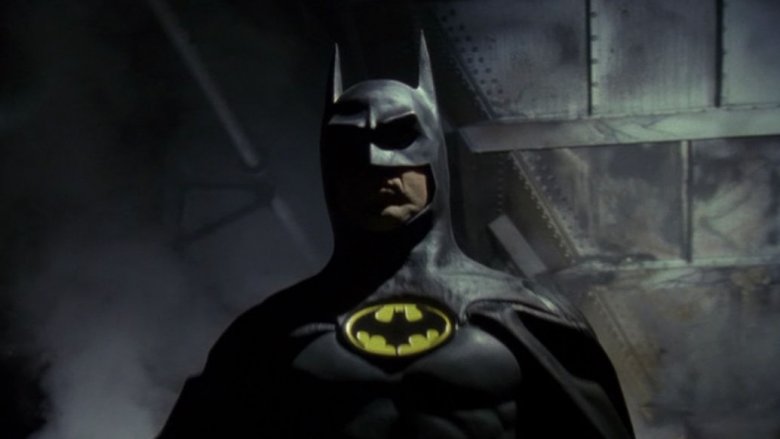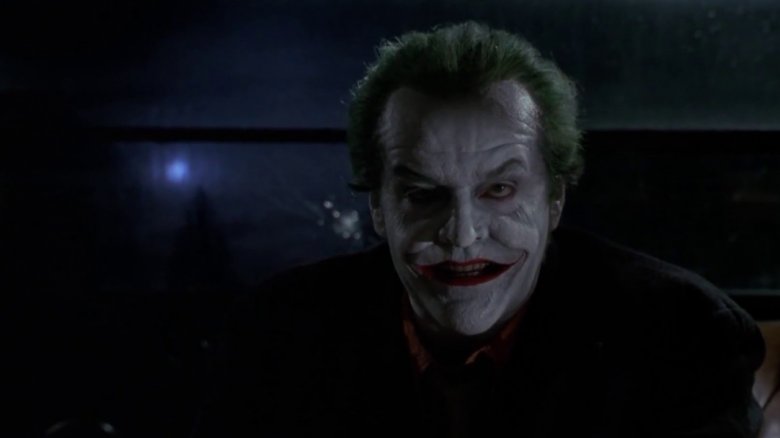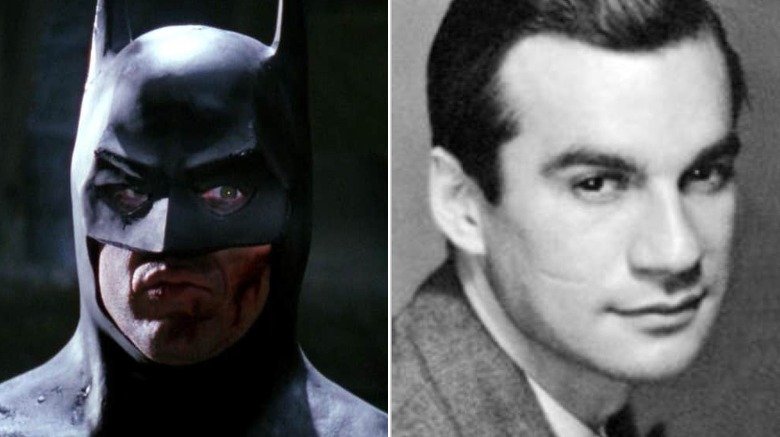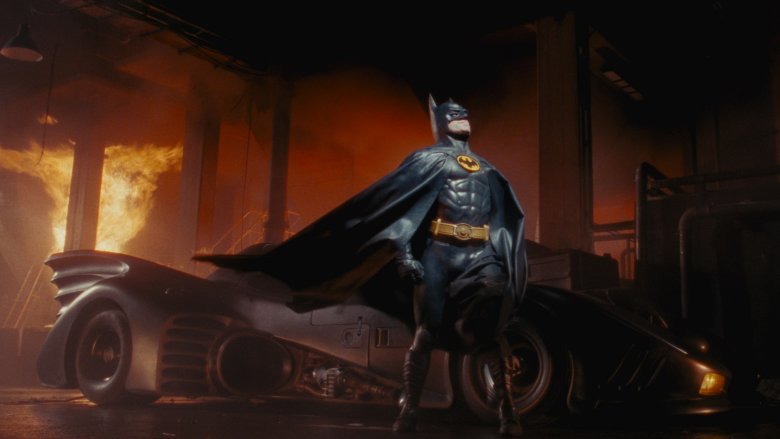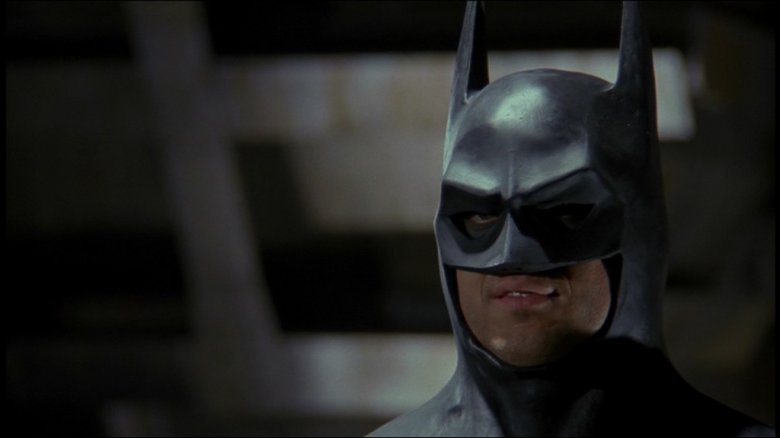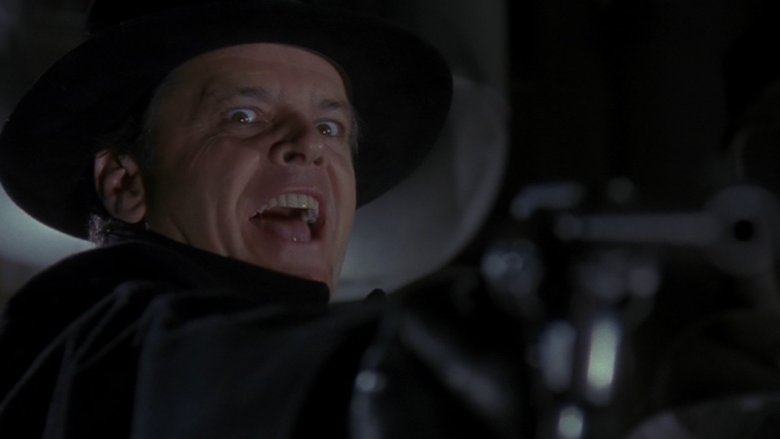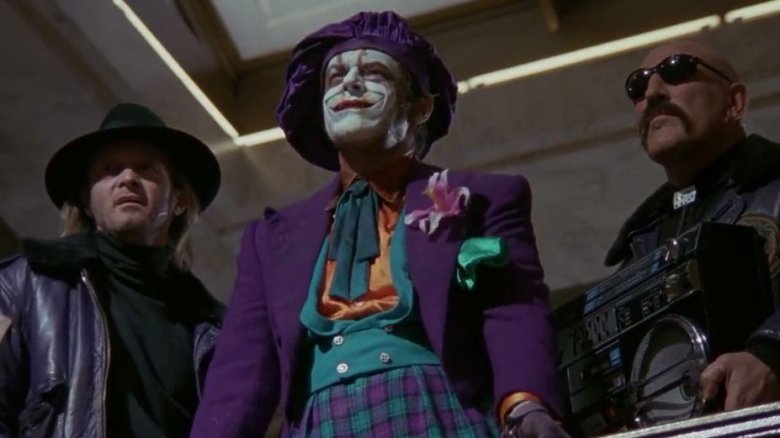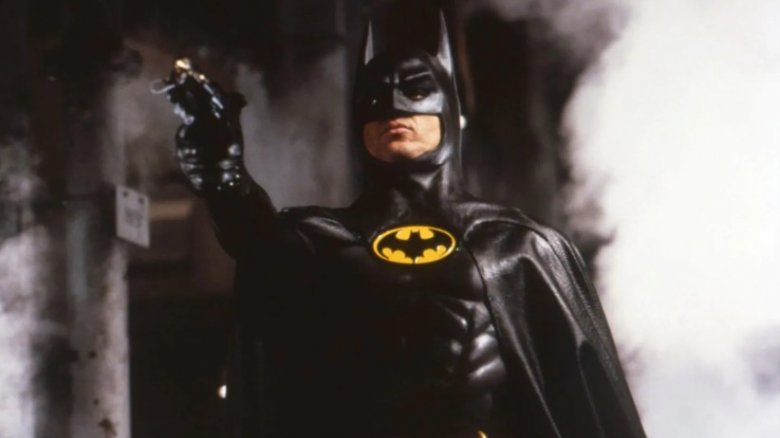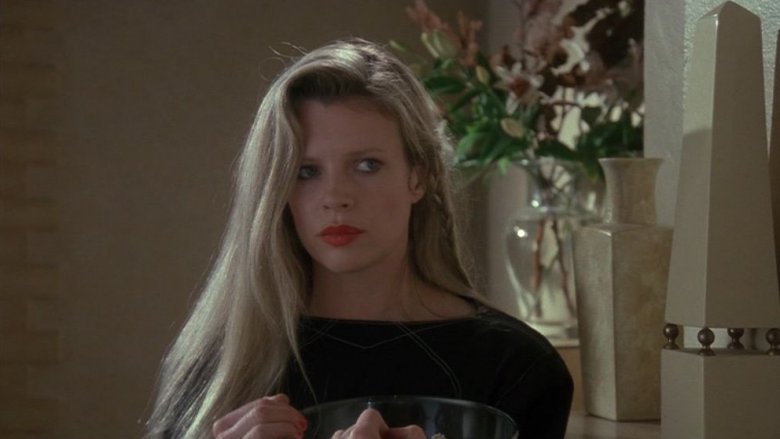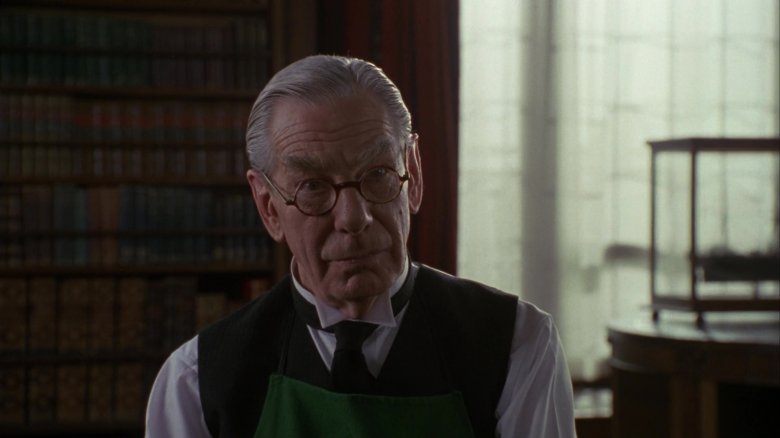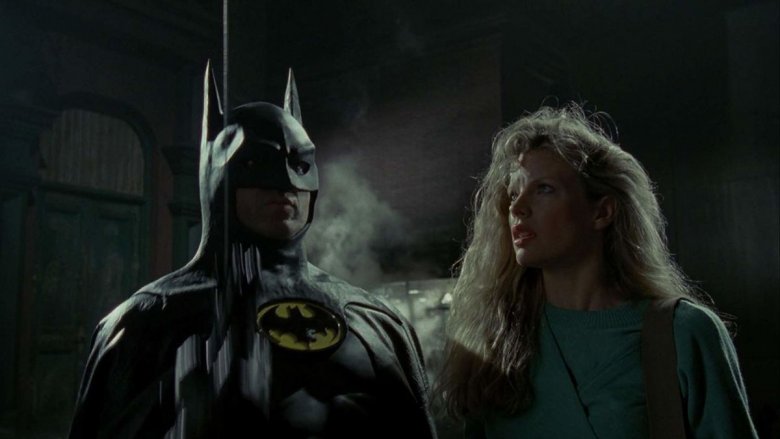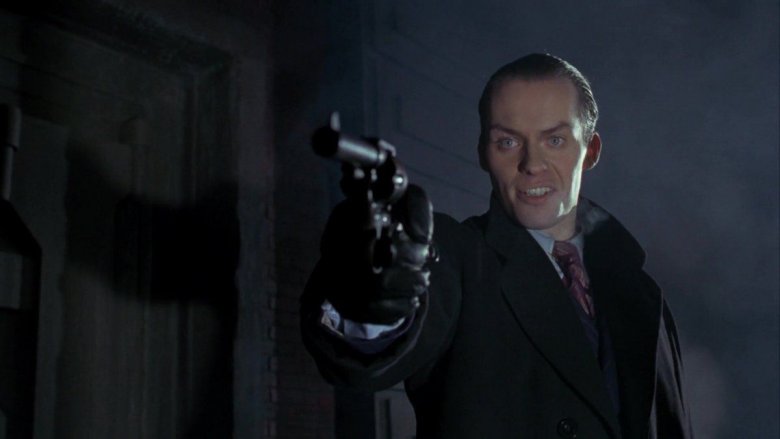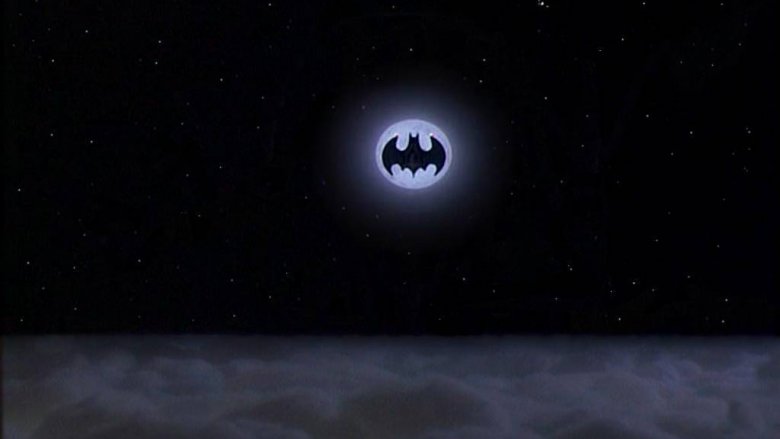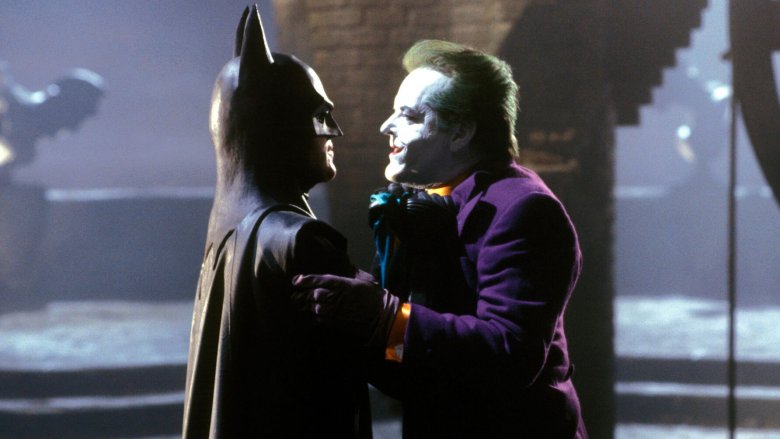Dumb Things In 1989's Batman Everyone Ignored
When it was released in theaters, 1989's Batman was a huge hit. Starring Michael Keaton as the titular Dark Knight and Jack Nicholson as the Joker, the movie made director Tim Burton a household name, mixing some of the camp of the 1960's Batman TV show with darker aspects culled from '80s Batman comics like The Dark Knight Returns and The Killing Joke.
Visually, Batman was dark not only in its lighting, but in the massive, oppressive nightmare it made of its setting: Gotham City. At the same time, many aspects of the film — like much of Burton's early work — couldn't help but feel more like a cartoon. Unlike the TV show, in 1989's Batman, the death of Bruce Wayne's parents is revealed as the hero's driving motivation, and the villain does more than just rob banks — he's a mass murderer. Nicholson is fascinating to watch and hilarious in the role, and the two opposing figures forge a conflict you can't look away from, with each being equally obsessed with the destroying the other.
But Batman is far from a perfect movie. Rewatching it with just a little bit of a critical eye reveals quite a few dumb things in the movie that we all just ignored.
One of the Joker's most iconic lines in Batman is inspired by an inconsistency
After murdering mobster Carl Grissom (Jack Palance) in Grissom's penthouse, Joker sits down at his old employer's desk, and the headline of a newspaper — "WINGED FREAK TERRORIZES GOTHAM" — catches his eyes. Joker angrily wipes Grissom's blood on the paper while reading out loud, "Winged freak... terrorizes?" He slaps the paper down, looks up, and delivers the classic line, "Wait 'til they get a load o' me."
It's a fun line, but it's set up by something that doesn't make any kind of sense: the fact that Batman is the subject of the headline. A few scenes earlier, we meet Alexander Knox (Robert Wuhl), a struggling reporter for the Gotham Globe who can't get anyone to listen to his big scoop. He's been tracking Batman since the first sightings surfaced, all while the cops he badgers and his fellow reporters treat him like he's chasing the boogeyman. When we first see him enter his newspaper office, another reporter obnoxiously reports, "Hey, Knox! They buried your story on the Batman!"
So, when a reporter's story is buried in Gotham City, that means it's printed on the front page?
Batman '89 doesn't mention Bill Finger
For far too long, Bob Kane received sole credit for the creation of Batman. The opening credits for 1989's Batman name Kane as the creator. Sadly, it's only been in recent years that the story of Bill Finger has received attention beyond the boundaries of comic book fandom. With efforts like the 2017 Hulu documentary Batman & Bill, more people know that one of the architects of the Batman mythos died without receiving credit or compensation for his ingenuity. As ScreenRant details, the Batman isn't the only major DC Comics character whose mythos Finger helped to create. While Finger had nothing to do with the initial creation of Superman, he did write some of the stories that introduced certain aspects of Superman's history — particularly when it comes to Krypton and its culture.
The issue dates back to the initial deal struck between Bob Kane and DC Comics in 1939, which granted Kane sole credit as Batman's creator in perpetuity. It wasn't until 2015 that DC Entertainment finally agreed to include Bill Finger's name as a co-creator in the credits of big and small screen adaptations like Gotham and Batman v. Superman: Dawn of Justice.
We're not arguing Tim Burton or anyone else involved in the making of 1989's Batman deserves to be shamed for keeping Finger's name out, especially since it was being kept out of Batman media altogether. Still, considering everything, if you're going to talk about dumb things about 1989's Batman, the absence of Finger's name has got to be toward the top of the list.
Batman can't move his neck
It's obvious in 1989's Batman that the suit designed for Michael Keaton doesn't allow for him to turn his head without moving his entire upper body. When he looks to either side, he swivels his entire torso to do so. It's especially obvious when he has to look up, as when he spots the Joker's helicopter overhead outside of the Axis Chemicals factory, or when he looks up quickly while racing up the stairs during the climactic cathedral chase. If he has to look at something that isn't already directly in front of him, he looks like a moving statue or, perhaps fittingly, an action figure.
Batman is supposed to be an expert hand-to-hand fighter, able to take on ninjas just as easily as he can random mob thugs. How is anyone supposed to be ready for attacks from any and every direction if they literally cannot turn their neck? Not to mention the difficulties it would create it in performing minor tasks like zip-lining through Gotham Museums, or even driving a car.
In 1989's Batman, Bruce Wayne is a killer
Batman doesn't kill (well, in most incarnations). Maybe he should — it's the classic Batman debate. Maybe it would be better if Batman broke a few madman necks rather than just throwing them into an asylum with the least effective security in the country. Regardless, Batman doesn't kill. But in 1989's Batman — oh, yeah — Batman totally kills, and that's without even counting Joker's death at the end.
At the end of the film, Batman kills one of Joker's thugs. The third of Joker's thugs to attack Batman in the bell tower seems to be getting the better of him, until Batman grabs the thug's head with his legs and hurls him all the way down to the ground floor. While that killing could possibly be called self-defense, earlier in the film Batman not only kills on a fairly large scale, but in a way that can only be called murder.
The first time Batman kills in the film, he remotely sends the Batmobile to Axis Chemicals. After Joker's henchmen futilely fire at the Batmobile, the vehicle releases a spherical explosive device which demolishes the factory. This must kill the henchmen, and if there happen to be any employees in the building at the time, they're almost certainly killed as well. Since it's an act Batman plans out beforehand — not to mention the fact that he's not even inside the Batmobile when it happens — there's no way to call that self defense.
Batman's Axis Chemicals Scene makes no sense
The fight at Axis Chemicals, ending with Jack Napier's fateful drop into a vat of chemicals, is ridiculous in a lot of different ways.
First, there's Batman's presence. Going there is a dumb move by a guy who's supposed to be a master strategist. Batman hasn't earned Commissioner Gordon's trust yet, so by showing up he makes an already complex and dangerous situation that much more confusing. Gordon already has to worry about Napier, his men, and any cops on the mob's payroll — now he has to worry about a dude in a bat suit too.
Second, there's Jack Napier's ability to manipulate the machinery in the factory so he can turn Axis Chemicals into a toxic obstacle course. We learn later that he apparently had an aptitude for biology and chemistry, but that's a far cry from being able to walk into a factory and know how to work all the equipment.
Finally, there's the murder of Lieutenant Eckhardt. One one hand it seems strange — when Napier calls out Eckhardt's name, the dirty cop is just lazily walking in the opposite direction, and he turns around looking like he's ready to fall asleep. On the other, the murder of Eckhardt is possible because Batman allows it. He lets go of Napier and disappears, apparently feeling it's totally fine to just allow the mobster to murder a policeman before bothering to attack him again.
The Joker builds an empire in an impossibly short amount of time
In 1989's Batman, Jack Napier goes from being a scarred chemical accident victim to the head of a criminal empire, seemingly overnight. While Vicki Vale and Bruce Wayne have dinner at Wayne Manor, Joker's face emerges from a surgeon's wrapping and he murders Carl Grissom. By the next morning, we've already seen him in two different purple Joker suits — the one he wears while murdering Grissom, and the second one he's wearing when Alicia (Jerry Hall) shows up and faints.
Before the morning is over, he's murdered a rival crime boss with an electrocuting hand buzzer, and his henchmen are already dressed in Joker-themed jackets bearing Joker-face patches. By the end of the afternoon, the Joker shows up in yet another outfit with his henchmen now dressed as mimes, and he's had the time to make a feather quill pen sharp enough to penetrate another rival mob boss' throat.
So, in literally less than a day, Joker recovers from his accident, somehow convinces an army of professional criminals that taking orders from a clown is a good idea, fashions himself with at least three different Joker-themed outfits, designs and produces enough Joker-themed jackets for all of his henchmen, and invents both a hand buzzer and a pen that can kill.
For a psychotic clown, the Joker has better time management skills than the Flash.
What's up with all the steam in Batman '89?
As soon as 1989's Batman begins, there are excessive plumes of steam everywhere. They're bursting out of every nook and cranny of Gotham City, and they're all over Axis Chemicals. Whether we're following a family of tourists about to get robbed, the robbers themselves, or the movie's titular hero, everyone's constantly surrounded by steam.
The steam, admittedly, helps to create a unique atmosphere in Gotham City. The steam seems to replace the blanket of fog found in your average 19th century London mystery, but once you watch Batman with a bit of a critical eye, the stuff is just comical. We're supposed to be getting the impression of an over-industrialized city, but instead you just wind up thinking, "Tim Burton really bought a lot of smoke machines."
There's no real world explanation for so much steam blasting from so many different corners of the city. It just seems like Gotham's buildings and sewers are populated by unseen giants, all of whom are constantly boiling water for tea.
Vicki Vale makes some very strange choices
Vicki Vale is one of the most infuriating characters of 1989's Batman. We're told she's a smart, accomplished photographer who's gained acclaim for her war zone journalism. But for someone who's spent her career on dangerous frontlines, her actions don't often make sense.
In the museum scene, Joker's gas either kills or knocks out (it's never revealed which) everyone else in the museum. Joker vandalizes the museum with his henchmen, lights candles with a pocket flamethrower, and rants madly about art. None of it seems to bother Vicki too much, until Joker summons Alicia and tells her to unmask, revealing... a burn scar. Vicki jumps up and screams. Using a chemical weapon on dozens of people? No worries. Destroying priceless pieces of art? Big deal. Get introduced to a woman with a scarred face? Holy hell, call the Marines.
Sometime later, Vicki is visited by Joker and his henchmen at her apartment. Joker places Alicia's cracked mask on Vicki's fireplace mantle and tells her Alicia killed herself. He makes a joke, smashes the mask with his fist, and cackles. Vicki's response? She grabs a bowl off the mantle and starts eating popcorn. Because that should help.
After Joker finally leaves the apartment, Vicki's very first action is to hurry to her dining room table to open the large package Joker left for her, eventually revealing a mannequin hand clutching dead flowers. She doesn't open it tentatively or carefully. She opens it as quickly as she can, even though anyone with a working brain should be calling the bomb squad.
The Alfred Pennyworth of Batman '89 is a pretty terrible caretaker
When it comes to Vicki Vale, Alfred the butler has a big, dumb blindspot that is inconceivable considering everything we know.
Alfred's overall pushiness with Bruce in terms of getting him more heavily involved with Vicki Vale is questionable, but when Alfred just leads Vicki right into the Batcave, it's insane. It's not a move imaginable of any of the other Alfred Pennyworths we've seen on the screen or comics page. While Michael Caine's brilliant portrayal in Christopher Nolan's Dark Knight trilogy shows us the butler isn't afraid to tell his employer exactly what he thinks, there are still lines he won't cross, and unmasking Bruce to someone without permission is one of them. If Joker or another villain were to try to torture Bruce's secrets out of him, it wouldn't work. He's certainly not going to do it just because he thinks Bruce is lonely.
Alfred's outing of Bruce is even more absurd when you remember Vicki Vale is a photojournalist working for a major Gotham City paper and partnered with a reporter hungry for Batman dirt. Alfred may as well invite a video crew in while he's at it. Maybe send postcards with Batman's address to all the inmates in Arkham Asylum.
Batman and Vicki's off-screen... love scene?
After Batman saves Vicki Vale from Joker and his thugs at the museum, he brings her to the Batcave. He gives her the information he's gathered on the make-up products Joker's poisoned, and when Vicki asks him why he really brought her there, he admits there is something else he wants, and then he covers our view of her with his cape. The next morning, she wakes up in her own bed, disheveled and obviously disoriented. She's fully clothed, but is dismayed to discover that Batman has confiscated the film she'd had in her pocket the night before.
Is the implication that he... knocked her out? Drugged her? Did something sexual happen? The whole idea is just absurd and a little disturbing to contemplate. Bruce and Vicki have already slept together at this point (see: the bizarre scene in which she wakes up to find him hanging upside down), but she doesn't yet know that Bruce and Batman are one and the same. Not to mention that Batman isn't exactly a sweet gentleman to Vicki Vale before revealing there's "something else" he wants from her. He's short with her, dismissive, and does things like shines a bright light in her face when she tries to get a closer look at him. So how exactly does he seduce her not only without revealing his secret identity, but by appearing like a sociopathic jerk?
A couple of things about Jack Napier killing the Waynes make no sense
One of the major ways 1989's Batman diverges from the comics is that it's revealed Jack Napier, a.k.a. the Joker, killed Bruce Wayne's parents. There are a couple of things about this reveal that don't fit.
First of all, there's the question of why. We see a flashback of Napier and his accomplice, and they look nothing like the filthy, desperate muggers from the beginning of the film who rob a family of tourists (an obvious bit of misdirection for comic fans expecting the movie to open with Batman's origin). Both Napier and his buddy are dressed in warm, expensive clothes. They don't look like the type to just randomly grab strangers and murder them for money.
Second, at the end of the film, Joker knows who Batman is and who his parents are. After Joker tells Batman "You made me!" by dropping him in the vat of chemicals, Batman responds that Joker murdered his parents. Joker says, "I was a kid when I killed your parents." How does Joker know when he killed Batman's parents unless he knows who Batman is? It isn't like Jack Napier doesn't have plenty of victims under his belt.
The Batman '89 version of the Bat-Wing is ridiculously specific
When Batman uses the Bat-Wing to save the people of Gotham from Joker's killer gas, it appears the already unique vehicle was prepared for precisely that eventuality long ago.
When Joker throws a parade for Gotham, he releases lethal gas from parade float balloons. Batman comes to the rescue in the Bat-Wing, activating a device that grabs the cable of each balloon. Batman takes the balloons high into the sky, then the Bat-Wing cuts each cable of each balloon, leaving them to float harmlessly away.
The thing is, there's no discernible purpose for the device Batman uses to gather the parade float balloons and cut them loose, other than to gather parade float balloons and cut them loose. It's as if, months earlier while watching Bruce Wayne design the Bat-Wing, Alfred said, "But sir, what if you need to gather many parade float balloon cables very quickly and then cut all of the cables at once?" To which Bruce responded, "Well duh, the parade float balloon gatherer/releaser is already on the schematics, Alfred!"
Joker's thugs in the final battle make no sense
There is a bit of problem in the final battle between Batman and the Joker in Gotham Cathedral's bell tower.
Joker shoots the Bat-Wing out of the sky, grabs Vicki, and orders his henchmen to send a chopper to the roof of the cathedral. Once he reaches the roof, he uses acid to send a large bell crashing down to the floor below, blocking access to the stairway. Luckily, Batman is already halfway up the stairway, but the Gotham PD is stopped in their tracks. Once Batman reaches the top, he is attacked by three of Joker's henchmen.
Where do the henchmen come from? The helicopter isn't there yet and Joker blocked access from the ground. He didn't know beforehand he would be going to the top of the Cathedral, otherwise he wouldn't have waited to call the helicopter. Which means either the thugs' presence is a big mistake, or Joker put thugs on the top floor of every building in Gotham just in case he needs them to fight Batman, which makes less sense than most things that make no sense.
